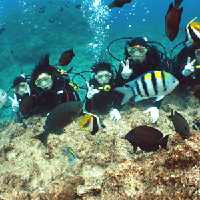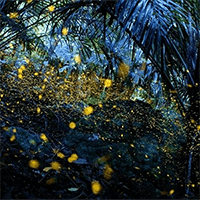List of rain
- Age 3~Age 60
- 2~3 hours
- 08:00
For families, how about a 3-hour fishing tour from early morning, afternoon, or evening when you are staying in the Fuji Five Lakes area? We also offer one-day sightseeing guides, skiing and snowboarding lessons, and Jukai and cave tours. This is a nature experience tour around Mt. Fuji, and is basically an experiential weekend plan for elementary school students and pre-schoolers who want to enjoy the great outdoors around Fuji. Girls can also participate as children. We look forward to your participation as a parent and child. Please arrive at Lake Motosu by 8:00 a.m. Fishing is best in the morning. In the summer, it is also possible to catch them in the evening. They also have the habit of eating stink bugs and cicadas. On the day, we will meet at Lake Motosu and start fishing for rainbow trout early in the morning at Lake Motosu. The theme is fish, animals, and insects in the great outdoors. We will give a fishing lecture in the morning and aim for native rainbow trout. While you are not catching any fish, we will plan various things to enjoy, such as rummaging around for Yoshinobori and catching insects (there are beautiful stink bugs), observing wild birds, and looking for driftwood. Please take this opportunity to enjoy rainbow trout fishing. Experience a pull that is far superior to that of trout caught at managed fishing areas. You can take home up to 10 fish you catch. Please bring ice in a cooler box. It is also convenient to bring a folding chair. The best time to fish is in winter, when you can fish in shallow waters, and in spring and autumn, you can fish a little deeper, and in summer, you can cast from the cliff and search for areas around 30 to 50 meters. So, this is a fishing that can be done all season, but the fish in North America are lively and delicious in the cold. Please purchase a fishing ticket under the supervision of the Lake Motosu Fisheries Cooperative Association. It costs 1,000 yen for adults. Also, I have been living here for 30 years. I have a villa near Mt. Fuji at 1,200 meters, so please contact me for sightseeing, meals, plans, etc. Recommended places are Fujinomiya Yakisoba, Mume-san Fujiyoshida Udon, Takegawa Hoto, Kosaku Hills Burger, Hand-made Soba at Lake Kawaguchi Oshino Hakkai, and Ikemoto Chaya Sightseeing, which has a Fuji Trout Farm, feeding, and managed fishing area. Fuji Kachouen Bird show, lots of owls Horse farm Animal feeding Strange rock museum Gem hunting challenge Fuji Safari Animals YETI Ski Resort Skiing Snowboarding Lessons available Oshino Hakkai Fuji Yusui no Sato Aquarium Guide also available Wild Bird Park Feeding available Fuji Jukai cave exploration Guide also available Fuji Jukai trekking 500 year old beech tree virgin forest Guide also available Subaru Land Fuji-Q Highland FUJITEN Ski Resort Skiing and snowboarding lessons are also available. Family visits are free. For small children under 3 years old, why not try catching small fish with a net? We look forward to your participation. Nogawa Nature School Sonoda (Tosshi) PS: The minimum number of participants is 5 or more.
- Age 3~Age 12
- 3~4 hours /Over 6 hours on the day
- 06:00
This is a tour for children only. It is scheduled to be held every day, but please contact us and apply for the tour. Starting early in the morning, you will fish for smallmouth bass, catfish, and carp using worms in the Tama River, or go carp fishing in the Nogawa River using bread ears as bait. (2 to 3 hours) Move to the forest to split wood for stag beetles and search for rhinoceros beetle larvae. (2 to 3 hours) After lunch, move to the river, rent rain boots, and experience searching for fish from autumn to spring. (2 to 3 hours) At the end, we will give a detailed explanation of how to care for the animals. {700th Anniversary Gift Items} 1. Dragonfly Brooch (worth 1000 yen) 2. Bucket or plastic case (worth 1500 yen) 3. 3COINS special eco bag + snacks + drink + lunch (assuming Gusto) Children will receive gifts worth 3000 yen or 5500 yen. ~Schedule~ Meet at Chofu Station or Fukadai Nigiwai no Sato around 6am Fishing starts at 7am Finishes at 9am Move to the forest at 10am to search for rhinoceros beetle and stag beetle larvae Lunch at Gusto 1pm to 3pm River rummaging (mainly loaches, oyanirami, moroko, and crayfish) 4pm to 4:30pm Explanation of living creatures in the garden (8 60cm aquariums with over 500 fish, 5 400L ponds) Ends at Chofu Station or Fukadai Nigiwai no Sato at 5pm We look forward to your participation.
- Age 3~Age 70
- 2~3 hours
- 09:00 / 11:30 / 14:00 / 16:30
Held from spring to autumn Fishing for Japanese eels in the brackish waters of rivers Part 1: 8:00-10:30 Part 2: 10:30-13:00 Part 3: 13:30-16:00 Part 4: 16:00-18:30 This is a tour to fish for eels at the mouths of rivers that run through Tokyo. Japanese eels are born in the western waters of the Mariana Islands. They grow in rivers not only in Japan but also in East Asia, including China, Taiwan, and the Korean Peninsula, and are known to return to the Mariana Islands to spawn. Japanese eels (Anguilla japonica), which belong to the Anguilla genus of the eel family, are widely distributed in East Asia, including Japan, China, Taiwan, and Korea. In Japan, they mainly live south of Honshu, but there have been cases of them being caught in Hokkaido. Rental tackle, fishing rod, and equipment are included, so you can participate empty-handed. Two patterns of fishing will be done: casting fishing and plastic bottle tackle fishing, using earthworms as bait. While waiting for the tackle, you can fish for goby at your feet. The main target is eels, but sometimes you can also catch goby, crabs, and seigo. The tour lasts about 3 hours. Please bring a headlamp, a handy light, and drinks. *If you want to take the fish home, please bring an aeration device (battery-powered bubbler) to prevent oxygen deficiency, a plastic case or fishing bucket to prevent escape, and a cooler box. By train: 15 minutes walk from JR Joban Line or Tokyo Metro Chiyoda Line By car: Please use a nearby parking lot Meeting place: Near the Seven-Eleven Katsushika Kosuge 1-chome store. We will send you a map in advance, so please walk to the point. Migration of Japanese eels Japanese eels spawn in the summer in the waters west of the Mariana Islands in the Pacific Ocean. After hatching, they become willow-leaf-shaped larvae called leptocephalus. Glass eels are carried by ocean currents and reach East Asia in about six months, then transform into long, cylindrical glass eels and ride the high tide into rivers. After that, their transparent bodies start to take on color, and they are called yellow eels. During the yellow eel stage, eels grow large, and eat a variety of foods, including shrimp, crabs, small fish, and insects. The environment in which Japanese eels spend their growth period is wide, from coastal areas to the upper reaches of rivers, and includes not only freshwater areas but also brackish water and seawater. After several years to a dozen years, when they grow to a size of about 40 cm or more for males and about 50 cm or more for females, they begin to mature and are called silver eels. Silver eels leave their familiar rivers and coastal areas and travel to spawning grounds from autumn to winter. They reach the spawning grounds in the Marianas in about six months, spawn, and then end their life. PS: The minimum number of participants is 5 or more.
- Age 3~Age 12
- Over 6 hours on the day
- 08:00
This is a tour for children only. Targeted from infants to elementary school students. ~ Flow of the day ~ Meet at Chofu Station or Shindai Nigi-no-Sato at 8:00 am (by car) If you would like to look for turtles and mitten crabs on site, please bring a bucket with you. After searching for turtles, we searched for crayfish and fish in the nearby irrigation canals. This is a nature experience program where you can catch fish in ponds around Chiba Prefecture. Lunch and dinner included (host's expense) We look forward to your participation.
最近チェックしたプラン
Please wait a moment
![[Yamanashi/Lake Motosu] For families! OK all year round *Lake Motosu*Rainbow trout lure fishingの画像](https://img.activityjapan.com/10/46608/10000004660801_atFOJjl6_3.jpg?version=1707259142)
![[Tokyo/Chofu] To commemorate the 700th Kids Special Adventure, a river rustling exploration tour will be held to search for larvae in the fishing forest (free rental of children's stupid boots)の画像](https://img.activityjapan.com/10/50731/10000005073101_HI9mCLeH_3.jpeg?version=1694742604)

![[Departing from Tokyo/Chofu] Kids Special Adventure children's tour bus fishing, soft-shelled turtle, and rock turtle hunting tour (free rental of stupid rain boots)の画像](https://img.activityjapan.com/10/47133/10000004713301_atFOJjl6_3.png?version=1709014263)







